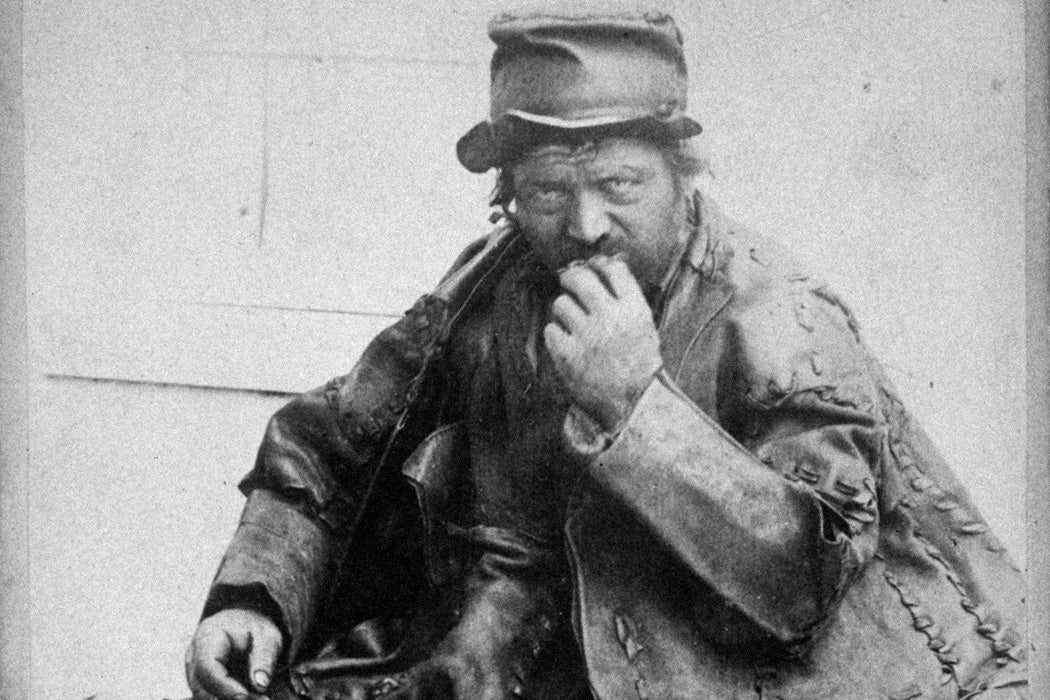He walked a constant loop, 365 miles taking him though western Connecticut and eastern New York. He repeated it again and again, every thirty-four days, clocking more than 100,000 miles between 1857 and 1889. He was a constant presence in these towns, and, as historian Jim Reisler describes in his book Walk of Ages, “[s]o punctual were [his] habits that the people who slipped him handouts and spare change could practically set their watches by him.”
This wasn’t an exaggeration. A 1984 New York Times article noted that “his appearance could be expected—so exact was his schedule—within a half-hour of the time he had last been seen in the same town.”
He was called the Leatherman, named for his sixty-plus pounds of homemade leather clothing. He wore it in all weather, all temperatures, a distinctive sight traversing communities on Connecticut and Hudson Rivers. Though his movements weren’t mysterious, almost everything else about him was. He both lived and died as an enigma, a living folk legend.
No one really knows what started him on his journey, and asking him directly didn’t reveal much. According to archaeologist Steven R. Cooper, “He rarely spoke, and it was reported to be mostly grunts and a little French.” He was generally welcomed in the towns he passed through, a bit of a surprise as the nation was gripped in a panic about vagrancy. As legal historian Joel E. Black writes,
Dislocated and itinerant men […] were labeled a “tramp menace,” and their presence in cities and on thoroughfares ignited a host of legal, economic, and moral condemnations in popular, middle-class media that lasted through the end of the nineteenth century.
The “anti tramp” panic became the locus of a host of legislation. Somehow, the Leatherman was able to avoid most of this scorn, with “ten Connecticut towns [passing] ordinances exempting him from the state’s anti tramp law,” writes Reisler. It seems that he was viewed as a curiosity as much as anything. “He never looked at people, but children were not afraid of him. They just watched,” one Connecticut resident recalled.
But his silence led to speculation. Some people decided, for reasons unclear, that he was Jules Bourglay from Lyons, France. And while it would seem that identification might slow, or at least dim, the myth-making surrounding him, it only deepened it. Bourglay carried his own mythos. A son of a woodcarver (or possibly a woodcarver himself), he’d fallen in love with the daughter of a rich man who’d made his fortune in leather. As the story went, he wanted to marry her but was instead given a job in her father’s business. His success in leather goods would prove that he would be a success in marriage, they all reasoned. But a bad investment, spearheaded by Bourglay, ruined the business. The engagement, and presumably his heart, was broken, and he fled France for the United States, walking while clad in the very material that had thrown his life into chaos.
Weekly Newsletter
Another story identified the Leatherman as a French shoemaker named Rudoph Mossey. His, too, was a story of love gone wrong. As he told a reporter who claimed to have interviewed him in French, he was a cobbler whose wife ran away to America with a friend of his. According to the Times article, “Mossey sold his business and sailed to the United States, where, after three years, he learned his wife was living in Connecticut.” But it was too late. By the time he’d tracked down his former friend, his wife had died. Told that she’d lived in many parts of the state, he walked from town to town, tracing her ghostly footsteps.
When he died in 1889, the Leatherman was buried in a grave marked Jules Bourlay. But not even death would end the curiosity. As Cooper explains, a plan was hatched to take a DNA sample, “solving once and forever, the mystery of who he was.” The Leatherman had the last laugh, though. When he was exhumed in 2011, “all they found were a few animal bones and old nails,” his body becoming part of the earth in which it was laid, a mystery forever unsolved.
Support JSTOR Daily! Join our new membership program on Patreon today.







